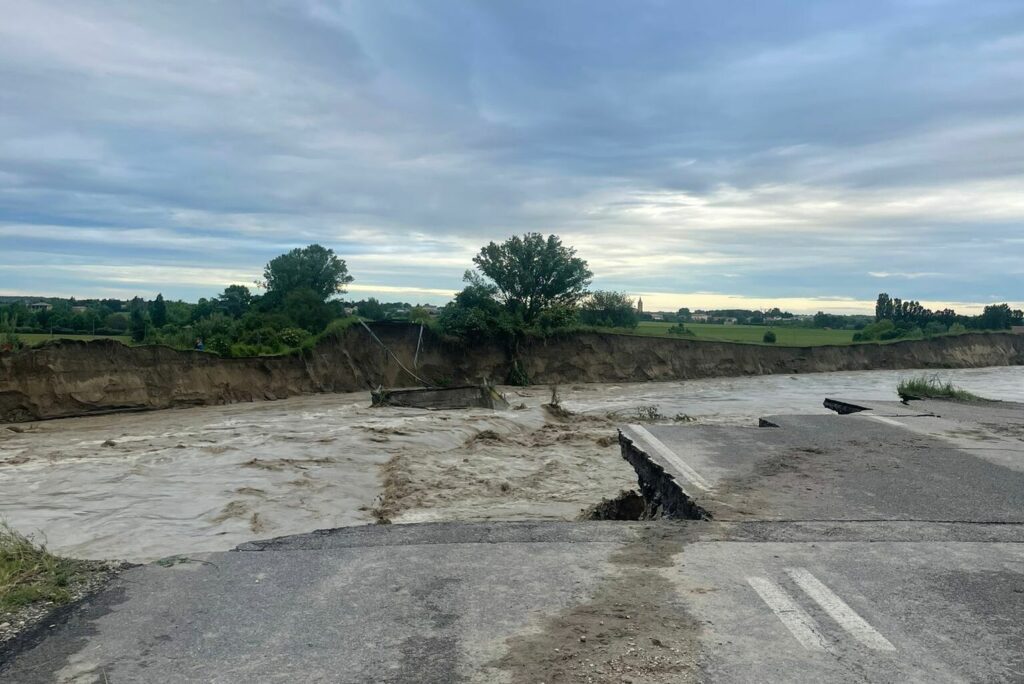
Eleonora Schiarchi
cultural heritage damages and collective recovery effort after the flooding in Emilia Romagna
 In early May, a series of intense floods struck several regions in Italy, with particular emphasis on Emilia-Romagna, located in the central-northern part of the peninsula. These natural calamities resulted in overflowing rivers, landslides, and mudslides, inflicting significant damage to the landscape. The tragedy unfolded in two phases, with fifteen days of almost relentless rain starting on May 2nd. Fifteen is the death toll, while fifteen thousand are the displaced individuals spread around the forty-four regional municipalities. The lives of the residents, whose connection to the land is oftentimes both professional and emotional, were tragically affected. Photographs and videos quickly started circulating on social media, spreading the image of an entire population grappling with a historically significant natural disaster.
In early May, a series of intense floods struck several regions in Italy, with particular emphasis on Emilia-Romagna, located in the central-northern part of the peninsula. These natural calamities resulted in overflowing rivers, landslides, and mudslides, inflicting significant damage to the landscape. The tragedy unfolded in two phases, with fifteen days of almost relentless rain starting on May 2nd. Fifteen is the death toll, while fifteen thousand are the displaced individuals spread around the forty-four regional municipalities. The lives of the residents, whose connection to the land is oftentimes both professional and emotional, were tragically affected. Photographs and videos quickly started circulating on social media, spreading the image of an entire population grappling with a historically significant natural disaster.
Amidst this devastating scenario, the cultural sector has suffered greatly. Gardens and parks such as the Cardello-Casa Oriani in Ravenna and the Ginanni Fantuzzi Villa, as well as important libraries like the Manfrediana Library in Faenza and the Malatestiana Library in Cesena, have suffered severe damage. Numerous museums have also experienced significant losses, including the Carlo Zauli Museum in Faenza, dedicated to ceramics and the renowned 20th-century sculptor that gives the name to the institution. The museum, which has been hosting events, artist residencies, and educational programs since 2002, suffered devastation in its basements, ground floor, and garden. Many artworks from its collection were destroyed, and the facilities and installations were damaged. In response to this tragedy, Matteo Zauli, the museum’s founder, along with his sisters, initiated a fundraising campaign accessible through the website https://gofund.me/51e5a625.
Despite the reduction in rainfall over the past two weeks, the hydrogeological risk alert shows no signs of abating. On Sunday, June 11th, the 41st consecutive alert was reported. To address this prolonged emergency situation, the severe weather decree was approved by the Council of Ministers at the end of May, providing immediate financial support of two billion euros. However, at present, the damages are estimated to amount to 8.8 billion euros, a figure that continues to evolve. This substantial gap may not be bridged in the near future, with severe consequences for the entire region. Thanks to the resilience and collective commitment of Romagna’s inhabitants, the situation seems to have temporarily stabilized, allowing for the start of the bathing season, crucial for the economy of the region. However, last-minute cancellations affecting around twenty percent of reservations along the coastline in June alone foreshadow a more challenging summer than anticipated.
The consequences of this catastrophe will not only impact the tourism sector but also, as mentioned earlier, the cultural sector. Numerous fundraising campaigns have been launched by both the Emilia-Romagna Region and the affected cities themselves. How to support the reconstruction and restoration of the damaged heritage? One notable project is ‘Romagna Tin Bòta,’ an initiative promoted by photographer Marco Onofri. It involves a fundraising campaign where photographers and illustrators donate their works to support the region’s recovery. Until June 30, through the website www.romagnatinbota.it, it is possible to purchase a high-quality A4-sized print. In addition to esteemed names like Oliviero Toscani and Guido Guidi, emerging photographers and illustrators have also decided to contribute to this cause. Donations start at a modest amount of one hundred euros, which includes the print and shipping costs. The proceeds will be allocated to the most affected areas of the flood through the partner organization Legacoop. All the artworks are also available on Instagram, on the profile @romagnatinbota.
With the message ‘Tin Bòta, l’Europa è con vo’ (Tin Bòta, Europe is with you), President of the European Commission, Ursula von der Leyen, addressed all those affected by the flood. Tin Bòta, which literally means ‘Stay strong’ in the Romagna dialect, means to wear boots and hit the streets, shovel away mud and water, and support those who have lost everything by welcoming, comforting, and assisting one another. Thus, Tin bota becomes the motto of resilience for an entire community that extends beyond regional boundaries, with its strength lying in the determination to rebuild the territory. Nevertheless, the great collective effort may not be enough.
To donate directly to the region, you can use the following bank details:
IBAN: IT69G0200802435000104428964. In the payment description, please write
ALLUVIONE EMILIA-ROMAGNA (Emilia-Romagna Flood)

